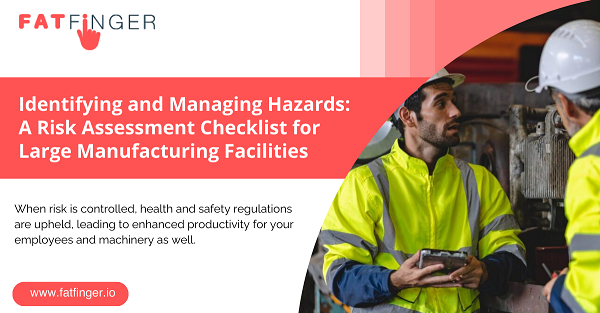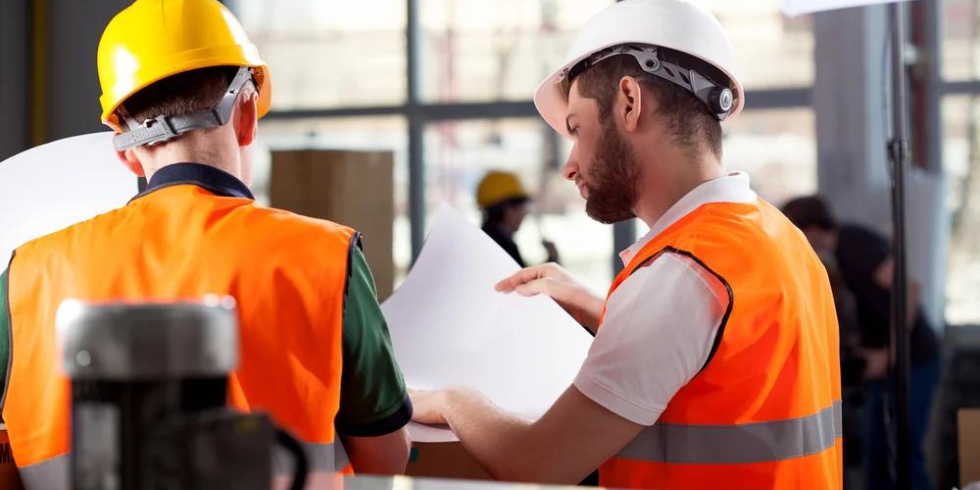If none of your workers have ever suffered injuries, you may be wondering whether they’ll always remain safe or if danger lurks nearby, waiting to pounce.
With a large manufacturing facility like yours, the latter is a strong possibility.
Large facilities face numerous hazards that can lead to severe worker injuries. Identify and manage these hazards through a risk assessment to ensure your workers are safe.
A risk assessment checklist is a powerful tool whose primary purpose is to help you evaluate potential risks and come up with ways to manage them.
With a risk assessment checklist, your workers will:
- Be able to identify hazards, enabling them to minimize incidents that lead to injuries
- Become more productive with a lower risk of accidents that result in downtime
- Feel empowered as they take responsibility for their safety, which increases their job satisfaction
Elements of a Risk Assessment Checklist

Definition: A risk assessment checklist consists of a series of questions or steps that guide front-line workers through specific situations in the workplace to help them identify and manage risks.
The checklist consists of these steps:
- Identifying potential hazards
- Evaluating the risk posed by the hazards
- Identifying strategies to eliminate or reduce risks
- Recording and communicating the findings
- Monitoring and reviewing risk control strategies
Such a checklist can be manual (on paper) or digitized.
Manual risk assessment checklists include filling out paper forms, which are time-consuming, prone to human error, and can lead to confusion. This results in your workers doing their tasks without putting safety first.
If your team is still using manual forms or relying on Excel work instructions and old software, you may have noticed that these methods aren’t reliable, especially when dealing with large volumes of data.
A digitized risk assessment checklist is a convenient and fast way of identifying and managing hazards at your facility.
FAT FINGER’s digital risk assessment solution is a digital procedures software (or a digitized clipboard) that enables your front-line workers to build no-code, drag-and-drop, mobile checklists in seconds.

Using the app, they can create digital forms or checklists on safety, maintenance, and operations by digitizing all their standard operating procedures with the help of step-by-step instructions.
The checklists have a user-friendly interface and work offline on desktops, laptops, Android, and Apple devices.
By using the FAT FINGER digital risk assessment solution, your front-line workers can employ workflow automation that keeps content at their fingertips, letting them capture evidence while working to prove they’ve done their work safely.
The video below provides more details on how to ensure your workers do their work correctly and safely all the time.
With that in mind, let’s now go through the risk assessment steps in detail.
Step 1 – Identifying Potential Hazards

Potential hazards are identified by collecting information about workers’ routines, their environment, tools, and equipment they use.
Before learning how to identify the hazards, you’ll want to understand the types of hazards that your workers might encounter. These may include:
- Biological hazards: These include bacteria, viruses, rodents, and venom from spiders and snakes. Health conditions such hazards cause include influenza, hantavirus, and muscular paralysis
- Chemical hazards: Corrosives, carcinogens, and flammables are examples. They cause health issues which include respiratory and dermatological problems
- Machinery hazards: Such as sharp or moving equipment. They can cause hair entanglement, stabbing, shearing of skin, and severing of body parts
- Physical hazards: Wet surfaces, loose cables, and poor lighting are examples. They can cause slips, trips, and falls
There are various ways to identify these hazards using the available sources at your workplace:
- Input from workers: Your workers can input verbally or through surveys. They’re familiar with the workplace and know the hazards they encounter every day.
- Self-inspection: Go around the facility and inspect production equipment, storage facilities, and various materials for any abnormalities.
- Records of previous injuries: Go through past injuries and near-miss injury records, and identify hazards that caused those incidents.
- Equipment and machinery manuals: Manufacturers often indicate in their manuals how their equipment can become a hazard if mishandled.
Besides using internal sources to get hazard information, there are several external sources, such as:
- Experts and consultants on safety and health matters in manufacturing industries
- Trade associations and advocacy groups, and safety and health consultative groups
- Websites such as the Occupational Safety and Health Administration site (OSHA)
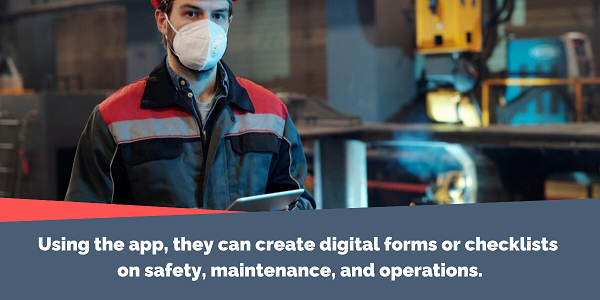
Worker Input Checklist: Identifying Potential Hazards
In the process of creating a safer work environment in a large manufacturing facility, the first step is to identify potential hazards.
An essential part of this step is gathering input from workers who have firsthand experience with the risks and challenges in their daily tasks.
To facilitate this process, below is an example of a guide for “Worker Input Checklist: Identifying Potential Hazards.”
- Prepare a survey or interview:
- Determine the format—surveys, interviews, or a combination of both.
- Develop a list of questions or prompts to guide the conversation.
- Schedule a time for conducting interviews or distributing surveys to workers.
- Conduct the survey or interview:
- Ask employees about their daily tasks and any hazards they encounter.
- Encourage open and honest communication, reassuring workers that their input is valuable and will be taken seriously.
- Probe for specific areas or processes where workers feel the most at risk.
- Document workers’ suggestions for improving safety in these areas.
- Compile and analyze worker input:
- Collect and review all completed surveys and interview notes.
- Identify common themes, concerns, and suggestions.
- Highlight areas with high levels of perceived risk or a high frequency of reported hazards.
- Prioritize hazards for further investigation:
- Rank identified hazards based on the frequency of mentions, perceived risk level, and potential severity.
- Determine which hazards require immediate attention and which can be addressed in the short or long term.
- Develop an action plan:
- Create a plan to address the identified hazards, including specific actions, responsible parties, and target completion dates.
- Involve workers in the development of the action plan to ensure their concerns are addressed and to promote engagement.
- Communicate the action plan to all employees and provide updates on progress and any changes made.
- Implement and monitor the action plan:
- Assign responsibility to the appropriate individuals or teams for implementing the proposed solutions.
- Establish a system for tracking progress on each action item, such as regular status updates or meetings.
- Monitor the effectiveness of the implemented solutions by gathering ongoing feedback from workers and comparing it to the initial concerns.
- Review and update the action plan:
- Periodically review the progress made on the action plan, and adjust as necessary to address any new or unresolved hazards.
- Celebrate successes and acknowledge improvements in hazard reduction.
- Encourage continuous worker input and involvement in hazard identification and risk management.
- Document and communicate the results:
- Maintain detailed records of the worker input process, identified hazards, action plans, and progress made.
- Share the results of the worker input process with all employees, emphasizing the positive impact of their involvement.
- Use the results to inform future risk assessments and safety initiatives.
Stay ahead of the game with FAT FINGER’s Job Hazard Analysis checklist and see how well you’ll identify potential hazards.
“We highly recommend this digital solution for anyone looking for an easy way to identify job hazards with minimal effort.”
— Johnson Martin, Safety Manager
After successfully identifying the hazards, the next step is to evaluate their level of risk.
Step 2 – Conducting a Risk Evaluation to Determine the Risk Level
Risk evaluation involves determining the risk level by considering how severe potential injuries could become, and their probability of occurrence.
Definition: Severity refers to the degree of injury your employees could suffer, or the level of damage your equipment can accrue from a hazard. It can be caused by system breakdown, human flaws, or deficiencies in procedures.
The below table categorizes the levels of severity in accordance with consequences:
| Severity Level | Description | Examples Of Consequences |
|
Catastrophic |
Procedures causing death or significant damage, requiring immediate ceasing of the dangerous activity |
Loss of life, total equipment destruction |
|
Critical |
Procedures resulting in serious employee injury, illness, or damage, requiring immediate correction |
Severe injuries, major equipment damage |
|
Marginal |
Conditions causing minor injury, illness, or system damage, but can be counteracted or controlled |
Minor injuries, minor equipment damage |
|
Negligible |
Conditions causing less than minor or no injuries, illness, or system damage |
No injuries, negligible equipment damage |
Probability is the likelihood of a hazard occurring. It’s ranked on this scale:
- Frequent: Likely to occur
- Probable: Will occur several times
- Occasional: Likely to occur sometime
- Remote: Unlikely, but possible it may occur
- Improbable: So unlikely that it may never occur
To determine the risk level, you can use these assessment types:
- Qualitative assessment: A subjective evaluation based on personal or expert opinions. You can also apply risk matrices and decision tree models.
- Quantitative assessment: Collect data and use it to calculate the risk level using methods such as event tree analysis, fault tree analysis, and hazard operability studies.
- Failure modes and effects assessment: Unlike quantitative and qualitative assessments that find a solution after failure, with this method, you’ll first identify the possible ways a product or process may fail and figure out solutions beforehand.
Although qualitative assessment is less precise than quantitative analysis—which relies on calculations for accuracy—it’s more flexible because it’s conducted using fewer resources.
Risk matrices are one of the most commonly used qualitative analysis methods.
Using a Risk Matrix to Calculate the Risk Score
A risk matrix is a formula used to determine the risk score by considering the severity of injuries or damage against the probability of incidence occurrence.
To calculate the risk level, apply this formula:
RISK SCORE = SEVERITY (CONSEQUENCE) ✕ PROBABILITY (LIKELIHOOD)
The more likely an incident will happen, the more severe the injury or damage.
For example, from the risk matrix below, an incident that is almost certain to occur has a risk score of 25, meaning it has the potential to result in catastrophic severity in injuries or equipment damage.
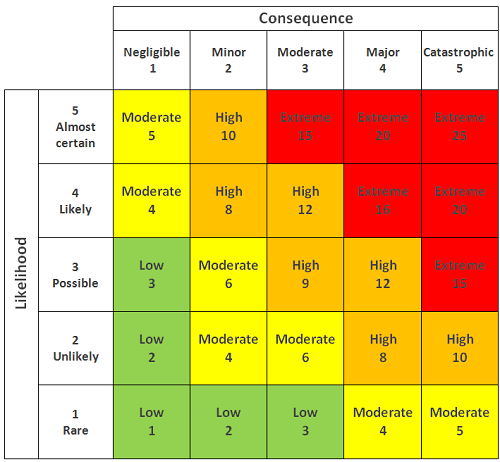
After assessing the risk level associated with each identified hazard, it’s time to apply appropriate control measures.
Step 3 – Implementing Risk Control Measures
Risk control measures are essential to eliminate or control the potential hazards that your workers may encounter.
The table below shows the different types of control measures you can implement, their description, and the benefits they’ll provide to your workers.
| Control Measure | Description | Examples |
|
Elimination |
Removing the hazard entirely |
|
|
Substitution |
Replacing one hazard with a less dangerous one |
|
|
Engineering controls |
Physical or mechanical modifications for collective or individual protection |
|
|
Administrative controls |
Policies, procedures, and practices |
|
|
Personal Protective Equipment |
Protective clothing and gear |
|
The illustration below ranks the effectiveness of these risk control measures.

When risk is controlled, health and safety regulations are upheld, leading to enhanced productivity for your employees and machinery.
To extend your machinery’s life, use a Preventative Maintenance Inspection checklist to help identify potential mechanical and electrical hazards by scheduling inspections and tests, which will save your engineering department precious time and costs.
“We’ve seen a significant reduction in downtime and long-term costs associated with manual maintenance processes. We’re pleased with FAT FINGER.”
— Jay Williams, Reliability Engineer
Step 4 – Documenting and Communicating the Risk Assessment
Once you complete the risk assessment checklist, it’s essential to document and communicate the assessment to your audience, and monitor the risk control measures implemented.
Effective documentation and communication involves providing clear information about how the risks you’ve identified can be eliminated or minimized through certain measures.
You can use these guidelines to help you document and communicate your assessment results:
- Determine your audience—whether it’s your employees, management, stakeholders, or regulatory bodies—so that you can tailor your document and language accordingly.
- Provide context around the risk assessment. What procedure did you apply to get to your final assessment results?
- Incorporate graphs, charts, and other visual aids to break down the information, helping your audience understand it better.
- Ensure you get subject experts such as stakeholders to review your report—they’re critical in validating your report.
- Keep adding the latest information to the assessment report so that it stays up-to-date for easy follow-up.
Step 5 – Monitoring and Reviewing Risk Control Measures
By monitoring and reviewing risk control measures, you ensure everybody does their work correctly, and that they stay safe.
To monitor and review these measures:
- Define monitoring indicators, such as the number of workers who comply with the risk control measures.
- Review the number of incidents that have happened after implementing the control measures.
- Rely on external and internal audits to assess the effectiveness of the control measures.
Run Smoother and Safer Operations With FAT FINGER Digital Workflows
As you strive to ensure operations at your manufacturing facility are safe and productive, we understand the frustration of relying on manual workflows. They trap you in a cocoon of stress and burnout.
FAT FINGER simplifies the process by ensuring your front-line teams do their maintenance and operations work correctly every time, using checklists, workflows, and digital procedures to unlock operational excellence.
Your workers can build and deploy enterprise-grade mobile applications to aid your facility’s risk assessment in seconds, using our drag-and-drop, no-code builder with real-time artificial intelligence coaching.
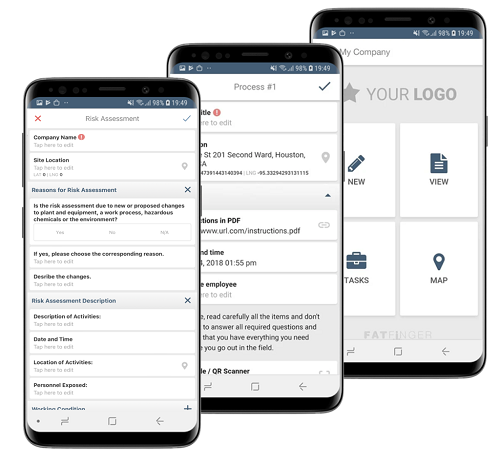
The world’s top-performing companies use our platform, from oil and gas, to field services and manufacturing. We’ve enjoyed working with top companies such as ExxonMobil, Tallgrass Energy, and Linde.
“FAT FINGER is so user-friendly it almost does all the work! It’s rare to find a program with everything users need”
— Kat M. Edwards Land
Call 1-800-987-1086. James McDonough and the team are waiting to provide your frontline workers with easy, fast, and digital operations to drive operational excellence.
Frequently Asked Questions
How often should risk assessments be conducted in a large manufacturing facility?
There isn’t a set timeline to conduct risk assessments. You can perform it annually or every six months; however, whenever you bring new machines, introduce new procedures, or receive incidence alerts, that’s an opportunity to conduct a risk assessment.
How much risk is acceptable in a large manufacturing facility?
The acceptable risk level depends on the size of your facility, the nature of your manufacturing processes, and the regulations governing your industry. This means you can’t equate the acceptable risk in larger facilities that run complex processes to the risk in smaller facilities.
What is the most effective way to monitor risk control measures?
The most effective way is to establish a comprehensive monitoring and evaluation system. Such a system includes key performance metrics, regular inspections, incident reports, data analysis, and continual improvement through new protocols and technologies.
Share on LinkedIn:
